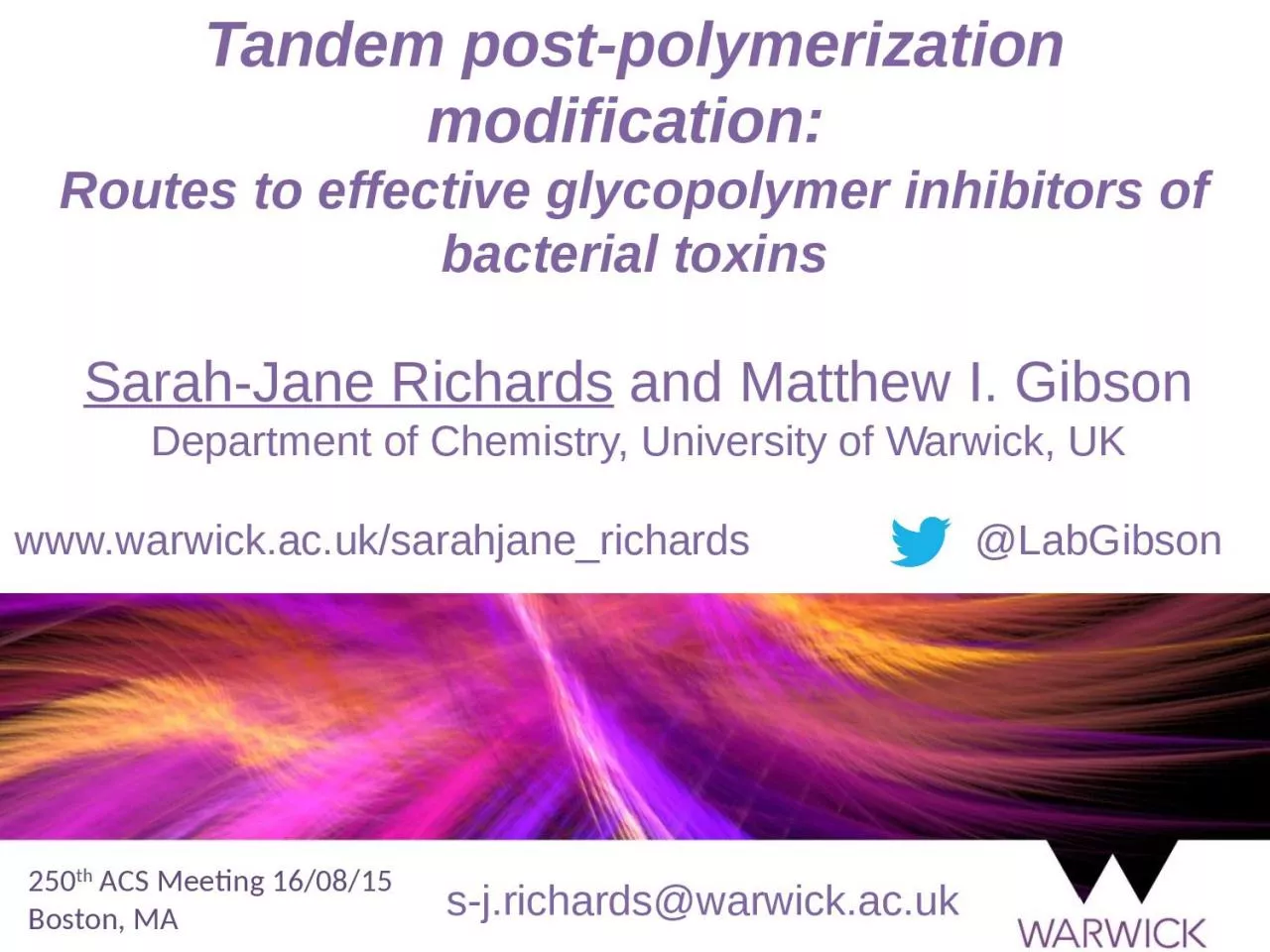

Routes to effective glycopolymer inhibitors of bacterial toxins s jrichardswarwickacuk SarahJane Richards and Matthew I Gibson Department of Chemistry University of Warwick UK LabGibson ID: 1043213
Download Presentation The PPT/PDF document "Tandem post-polymerization modification:" is the property of its rightful owner. Permission is granted to download and print the materials on this web site for personal, non-commercial use only, and to display it on your personal computer provided you do not modify the materials and that you retain all copyright notices contained in the materials. By downloading content from our website, you accept the terms of this agreement.
1. Tandem post-polymerization modification: Routes to effective glycopolymer inhibitors of bacterial toxinss-j.richards@warwick.ac.uk Sarah-Jane Richards and Matthew I. GibsonDepartment of Chemistry, University of Warwick, UK@LabGibson250th ACS Meeting 16/08/15Boston, MAwww.warwick.ac.uk/sarahjane_richards
2. Glycans are Crucial BiomarkersSelection of N-linked mammalian glycans d/load from P Stanley LabCholeraRicinInfluenzaEbolaShiga ToxinsHIVNon antibiotic solutions to resistanceTreatmentDiagnosisUnderstanding
3. Post-Polymerisation Modification J. Pol. Sci. A., 2007, 45, 2059/ Angew. Chem. 2009, 48, 48Predicted linear responseStructural Biology – Organic SynthesisCell Surface Glycans – Materials Science/multivalency
4. Post-Polymerisation Modification J. Pol. Sci. A., 2007, 45, 2059/ Angew. Chem. 2009, 48, 48
5. Glycopolymers by Post-Polymerisation ModificationJones, M. W., Richards, S-J., Haddleton, D. M. Gibson, M. I.; Polym. Chem., 2013,Jones, M. W., L. Otten, Richards, S-J., Lowery, R., Phillips, D. J. Haddleton, D. M. Gibson, M. I.; Chem. Sci., 2014Richards, S-J., Jones, M. W., Hunabun, M. I., Haddleton, D. M., Gibson, M. I.; Angew. Chem., 2012
6. Carbohydrate binding domainEnzymatic domainBinds to epithelial cells to promote cell uptakeInduces toxic effectSelective Binding of Cholera-ToxinGM-1 gangliosideβ-D GalactoseGalectins – at least 13Sigma-Aldrich – 8 Galactose-’specific’ lectinsHow do we engineer a high-affinity binder for cholera toxin, without total synthesis of complex carbohydrates?Anti-adhesion therapy does not target bacteria, so less evolutionary stress
7. Kiick et al.; Macromol. 2007, 40, 7103 and Biomac., 2006, 7 483Peanut AgglutininCholera ToxinGlycan Accessibility as a Tool for Lectin Specificity6.3 Å16 Å
8. Easy to make 50 gram scale1 column/distillationCompatible with RAFT/ATRPQuantitative functionalisation with non-hindered aminesDensity controlSequentially modified polymer librariesTheato, P.; J. Pol. Sci. A., 2008, 46, 6677
9. Glycopolymer LibraryPolymerDP[a]Linker[b]Density[c]Mw/Mn[d]GP118Short1001.29GP233Short1001.27GP370Short1001.26GP418Long1001.32GP533Long1001.28GP670Long1001.27GP733Long501.23GP833Long251.21GP933Long101.20
10. Peanut AgglutininPolymer lengthShort LinkerLong LinkerCholera ToxinShort LinkerLong LinkerPolymer length
11. Improved Synthesis with Poly(azlactones) 100 % Atom efficient Quantitative conversion with unhindered amines Scalable synthesis of monomer One-pot, two step synthesis/post- polymerisation modification possibleJones, M. W., Richards, S-J., Haddelton, D. M., Gibson, M. I.; Polym. Chem., 2013M.E Buck & D. M Lynn, Polym. Chem., 2012, 3, 66
12. Bio-Inspired Glycan-Mimetic, Selective GlycoPolymersCtx with GM-1Crystal StructurePolymer Design ConceptTran et al., OBC, 2011, 9, 3658
13. Variable 2o binding motifCarbohydrateFixed multivalent ScaffoldOptimisedLinkage LengthTandem Post-Polymerization3 Modification Strategy
14. Influence of Secondary Binding MotifsCholera ToxinPeanut Agglutinin
15. Identification of a Cholera Selective GlycopolymerCTx Selective GlycopolymerNon-Selective Glycopolymer
16. SummaryChem. Sci., 2014, 5, 1611 Binding Site AccessibilityAllosteric Interactions Angew. Chem. Int. Ed., 2012, 51, 7812<<<Cholera Inhibition Activity
17. Dr Matthew GibsonProf. Dave Haddleton Dr Mathew JonesCurrent Gibson Group MembersDr Gemma-Louise Davies - Daniel Mitchell Dr Daniel Phillips - Ben MartynDr Tom Congdon - Lewis BlackmanCaroline Biggs - Sang-Ho WonLucienne Otten - Laura Wilkins Acknowledgements
18. Tandem post-polymerization modification: Routes to effective glycopolymer inhibitors of bacterial toxinss-j.richards@warwick.ac.uk Sarah-Jane Richards and Matthew I. GibsonDepartment of Chemistry, University of Warwick, UK@LabGibson250th ACS Meeting 16/08/15Boston, MAwww.warwick.ac.uk/sarahjane_richards